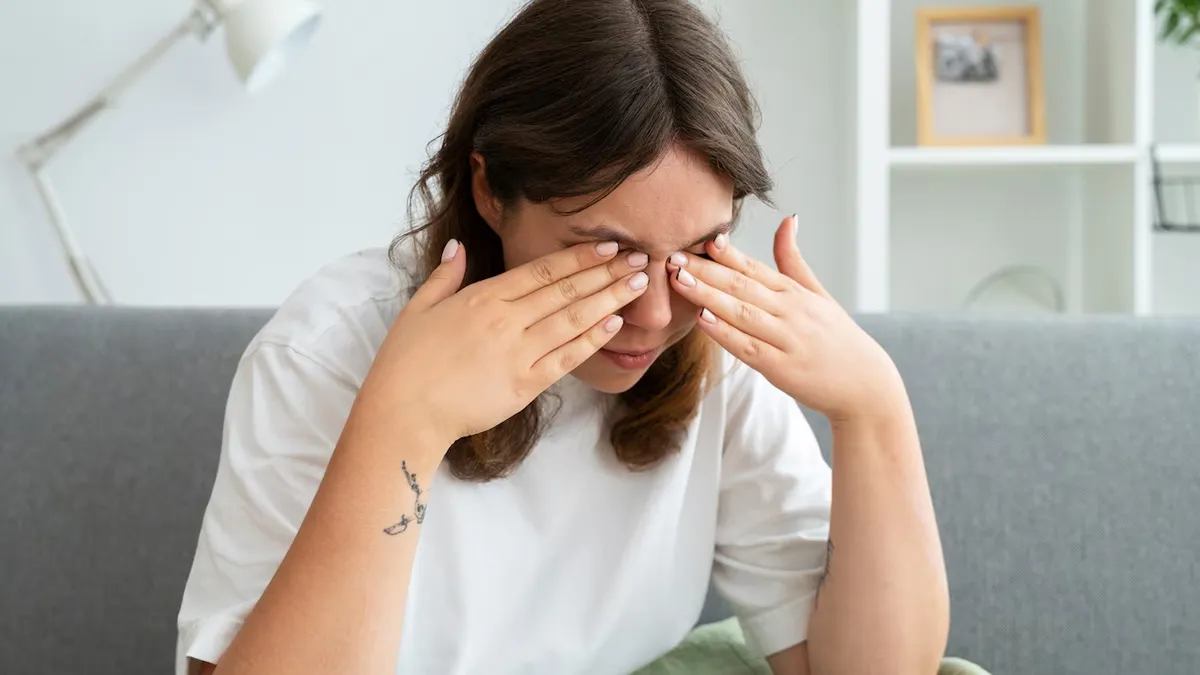
As the Diwali celebrations settle and the onset of winter begins in the northern part of India, a thick layer of air pollution covering the skies of most metro cities has become one of the major reasons causing dry eyes. Due to deteriorating Air quality Index (AQI), several health concerns have started taking the centre stage including dry eye syndrome. To discuss how air pollution affects dry eyes, its severity and when one should visit a doctor, Onlymyhealth editorial team reached out to Dr Bhavya Reddy, Consultant - Ophthalmology, Aster Whitefield Hospital, Bengaluru.
Table of Content:-
To understand the subject better, Dry Eyes or Dry Eye Syndrome is a condition when your eyes do not produce enough tears or a layer of lubricant that cover your cornea and keep the surface smooth. The situation occurs when your eyes fail to produce enough tears or when tears evaporate too quickly, leaving a feeling of stinging and burning.
Dry Eye Syndrome and Its Severity
According to a Cleveland clinic report, dry eye syndrome is a condition that affects the tear film, the three layers of tears that protect the surface of your eyes. As a result, the patient feels dry, irritated, or a burning sensation in their eyes. If not treated in time, dry eyes can even become severe, leading to corneal scarring, corneal ulcers, infection and even vision problems.
Talking about its severity, Dr Bhavya Reddy mentioned, “Long-term dry eyes may cause discomfort that is always present, the inability to bear light, and even blurred vision. At the extreme, the corneal surface may become damaged which increases the likelihood of infection, ulcers, or even scars that may cause permanent vision loss.“
Also Read: Blue Light and Your Health: Is Screen Time Ageing Your Eyes?
Dry Eyes and Link To Air Pollution
Air pollution has a broad list of negative effects on human health, but when it comes to dry eyes, it is still less recognised. The smoke, dust and chemical contents present in air pollution have made it a major contributor to dry eye syndrome.
Dr Reddy explained, “The pollution sources include particulate matter (PM2.5 and PM10), nitrogen dioxide, carbon monoxide, and ozone that irritate the eye's surface and cause inflammations. These harmful materials may lead to the destabilisation of the tear film, thus increasing tear evaporation and decreasing tear production.” She added, “The continued breathing of polluted air also results in the destruction of the meibomian glands which provide the oily layer of the tear film, thus limiting tear evaporation.”
Symptoms
Here are some of the symptoms you may experience with dry eye syndrome:
- Blurry vision for longer durations, especially while reading, whether a physical book or on screen.
- Having a constant feeling of stinging and burning.
- A scratchy feeling in your eyes, as if unusual is there on the eye surface.
- Redness and irritation in the eyes.
- Pain while wearing contact lenses.
- Sensitivity to light.
- Stings of mucus in or around the eyes.
- Watery eyes, where tears continuously flow from your eyes to the cheeks. Though it may feel unusual, your eyes make more tears when you have dry eye syndrome.
Protective Measures
As suggested by Dr Reddy, here are some of the protective measures you must take while experiencing the dry eye syndrome:
- Limit going outside during high air pollution levels, or use wraparound sunglasses or protective goggles when stepping out.
- Avoid exposure to cigarette smoke.
- Try not to use a hair dryer.
- Use a humidifier in your rooms, especially in winter, to maintain humidity.
- Keep eyes safe from dry wind, dust and tiny particles.
- Wash your eyes frequently with normal or cold water.
- Use a heat patch to warm compress your eyes.
- Take regular breaks from digital screens and rest your eyes for a few minutes.
- Include Omega-3 fatty acids in your diet.
Also Read: Monsoon Maladies: Your One Simple Fix for Chronic Dry Eyes, Says Expert
When To See A Doctor?
If the symptoms of dryness last for more than a few days and the use of lubricating drops does not bring any relief, then you need to see an eye specialist. Dr Reddy shared, “Immediate help is necessary when you have blurred vision, pain, excessive tearing, or light sensitivity. An ophthalmologist can provide appropriate treatment such as prescription drops, anti-inflammatory medications, or punctal plugs that help keep natural tears.”
Bottomline
Air pollution is less recognised but is a major contributor to dry eye syndrome. With the air quality deteriorating in several cities, air pollution has taken a serious toll on eye health. Even the indoor air pollutants coming from sources such as cigarette smoke, incense, and cooking fumes plays a role in the problem. However, with timely measures, dry eyes can be managed effectively.
Also watch this video
FAQ
Is it normal to have dry eyes all the time?
It is normal to experience dry eyes once in a while, but having constant dryness is not normal.Does Air Pollution cause dry eyes?
Yes, Air Pollution can cause dry eyes.Do air purifiers help dry eyes?
Keeping the humidity level between 30 to 40 per cent helps reduce the itching and irritation caused by dry eyes.
How we keep this article up to date:
We work with experts and keep a close eye on the latest in health and wellness. Whenever there is a new research or helpful information, we update our articles with accurate and useful advice.
Current Version
Oct 31, 2025 09:03 IST
Published By : Sameeksha Sharma